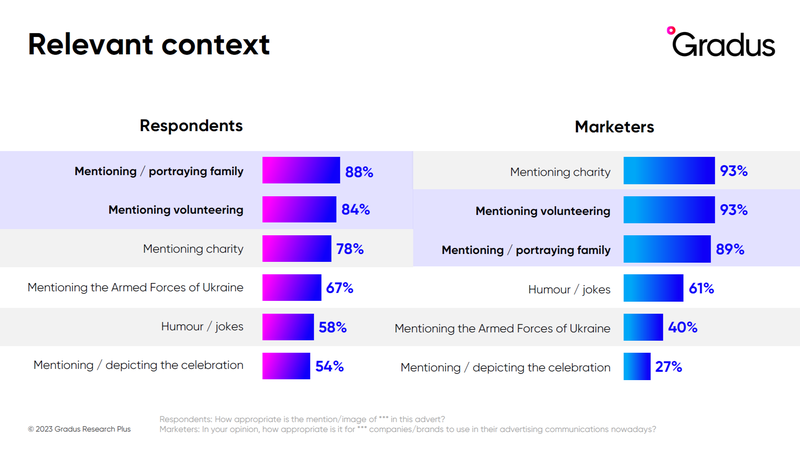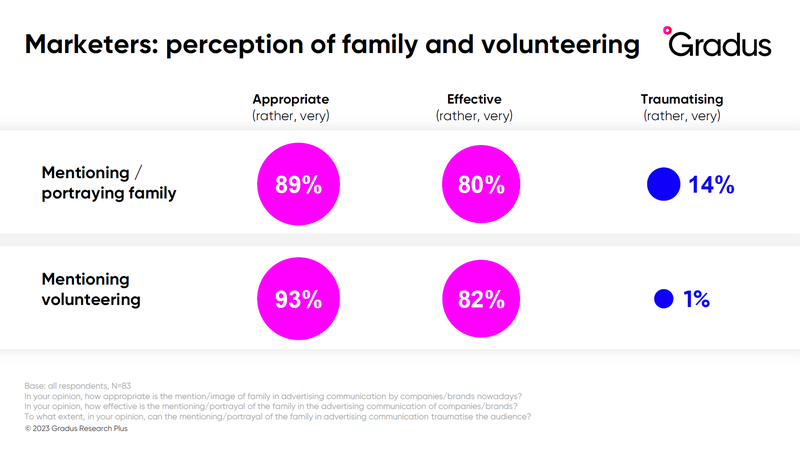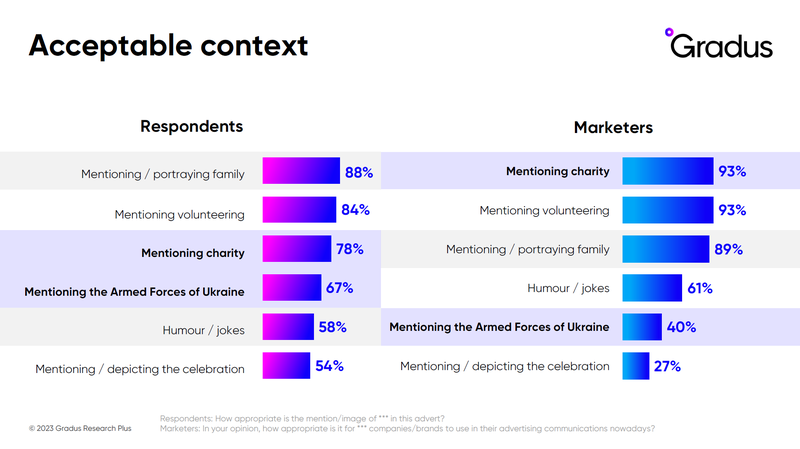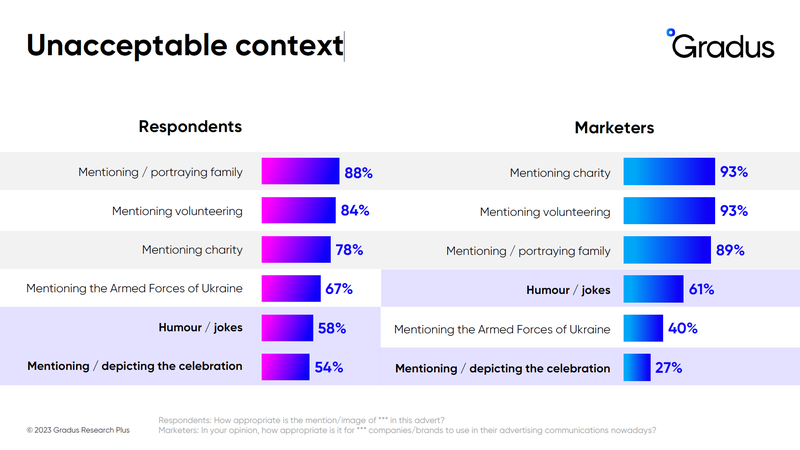Red lines in brand communications during the war

The question "What can brands communicate and what should they keep silent about?" remains acute, as the context changes very quickly during the war: something happens, and what was perceived positively by the audience yesterday can suddenly turn traumatic. In the almost one and a half years of full-scale war, many brands in Ukraine have suffered reputational risks and found themselves in the middle of scandals due to the inappropriate use of context and symbols in their communications. Especially for the Ukrainian Marketing Forum, Gradus Research conducted a study to find out what ordinary Ukrainians see as red lines in communications and compare them with the opinion of marketing professionals, and on this basis formulate new norms of what is appropriate and what is unacceptable in advertising during the war.
The project consisted of three studies. On the one hand, Gradus Research tested 150 branded commercials that have been shown in Ukrainian communication channels since the beginning of the full-scale invasion on a sample of over 5,000 people using its Gradus AdSpot methodology. On the other hand, two surveys were conducted among chief marketing officers (CMOs): a quantitative survey where CMOs were asked to assess whether certain categories of ads/communications were acceptable or unacceptable during the war, and in-depth interviews where CMOs explained the subtleties of the context - for example, what kind of celebration is acceptable and what is not.
"War is finally our new normal. This is evidenced by the surveys of ordinary Ukrainians, the surveys of the SMO, and other businesses. The horizon of expectation for the end of the war in all groups has been pushed back. If at the beginning of the war we all lived in the paradigm of "two or three weeks" or "a year at most", now the vast majority believe that active hostilities will last until the end of 2024. What does this mean? Both the media and consumers live with the understanding that the war will not end tomorrow, and we are in this context non-stop," says Evheniia Blyzniuk, sociologist, founder and director of Gradus Research.
This, in turn, creates conditions in which brands need to continue to communicate to drive sales or work on brand image, but not to "slip on thin ice". This requires an understanding of the context and its perception, which is also constantly changing.
The study looked at six of the most common contexts in advertising created after Russia's full-scale invasion of Ukraine. Based on the survey results, they were divided into three groups: appropriate, acceptable, and dangerous for communication. The SMOs additionally determined whether each context was appropriate, effective, or traumatic for the audience.
Family and volunteering - an appropriate context

In general, both consumers and marketing professionals (CMOs) have the same attitude towards the depiction of family and the mention of volunteering in advertising and consider it appropriate in brand communications in wartime. However, it is interesting that for CMOs, the topic of family is considered risky due to the fear of marketing experts that family will be a traumatic context for consumers. Why: Because they believe that people with divided families or people who have lost loved ones in the war may have negative connotations. However, the majority of marketers in in-depth interviews spoke about family as a support, a value, an opportunity to receive moral support and stabilise their psychological state.

It is also important to note that family and volunteering are the most prominent topics in the positive emotions segment. This context has a calming and positive effect on consumers.
It is acceptable to talk about charity or mention the Armed Forces in advertising

Mentioning charity or the Armed Forces can be classified as acceptable contexts. For CMOs, the mention of charity is number one (93% of surveyed marketing directors think so). That is, in the opinion of brands, this is the most positive acceptable context they can use in communications. Mentioning the Armed Forces of Ukraine is considered acceptable by only 40% of the surveyed CMOs, and in this area, brand holders feel that there is a danger of getting the context wrong and using an unacceptable symbol.
For the respondents, these two groups - charity and the Armed Forces - are the least emotionally charged, i.e., they are emotionally "curtailed" and do not provoke involvement or empathy. On the one hand, the Armed Forces is an emotionally charged topic, but in the middle of the second year of the war, there is an understanding that people are tired of this context, they have enough news and what they live in. Instead, charity, because it is perceived by people as top-down assistance, looks like a manifestation of special PR and does not engage people emotionally either.
At the same time, chief marketing officers (CMOs) are convinced that charity is the safest context for brands, with virtually zero potential for injury. CMOs believe that it is normal to help and talk about charity. And since brands spend a lot of resources on this area of work, they want to talk about it and have the right to do so. As for the mention of the Armed Forces of Ukraine, 25% of the surveyed CMOs consider it potentially traumatic.
Parasitising on the symbols of the Armed Forces, depicting celebrations or jokes is unacceptable

According to marketing directors, it is unacceptable to parasitise on the symbols of the Armed Forces. Here we are talking about the manipulative use of symbols, the so-called "bayraktarshchyna". They also consider it unacceptable to use sensitive topics in communications, for example, mentioning the events in Bucha or Irpin, as they provide emotional feedback, but of a traumatic nature. In the opinion of the SMO, the military context can only be used in terms of very specific examples or stories.
Compared to other contexts, humor/jokes and mentions/images of celebration are among the least appropriate for use in wartime advertising. Thus, humor/jokes are recognized as appropriate by 61% of CMOs and 58% of respondents (compared to, for example, 89% and 88% in assessments of the appropriateness of mentioning in advertising communications of the family). Despite the fact that these are the least safe categories to use, it is worth paying attention to the fact that they are still quite highly positively charged. It is "thin ice", but the audience still needs this context. Humor remains the nation's antidote to stress, and CMOs voice the idea that if ordinary people continue to joke on social media and create memes, it means that brands can too, just with some caution.
As for the perception of the image of celebration in the new context, loud, wild celebrations are unacceptable symbols in communications, but celebrations that take place in a close family circle are still perceived normally by consumers.
"And there is another emotion that is in great demand among consumers - joy. Joy is not necessarily in the context of celebration or jokes, it can be charity, the Armed Forces, but positive is what brands can deliver to their consumers by supporting them. Joy is appropriate, delicate and supportive. And joy should definitely be expressed in communications, because it helps people move on with their lives," comments Evheniia Blyzniuk, sociologist, founder and director of Gradus Research.
New advertising benchmarks created by Gradus Research based on measurements of actual wartime commercials will help brands and companies avoid a reputational crisis and create communication that will be accepted by consumers. In addition to the standard indicators of brand and product recognition, emotional perception of the video, involvement in the plot or motivation, it is also possible to measure how well the new video meets the requirements of society for wartime ethics, whether the context is acceptable, whether the use of symbols such as mentioning the Armed Forces, volunteering, demonstrating celebrations, entertainment, jokes or happy families is appropriate.
The full survey report is available for download via the form below
The survey was conducted by Gradus Research specifically for the Ukrainian Marketing Forum using a self-administered questionnaire in the Gradus mobile application. Audience of the survey: general audience (5000 respondents) - men and women aged 18-60 living in cities with a population of more than 50 thousand (the sample reflects the structure of the target group by age, macro-regions and size of the settlement, except for the temporarily occupied territories and territories where military operations are underway); SMO audience - 83 experts. The survey was conducted from 29 May to 12 June 2023 among the general audience and from 15 to 20 June 2023 among the SMO audience.
Other reports
-
 Life Quality Barometer 2025July 2025Joint study with EBA on the impact of full-scale war
Life Quality Barometer 2025July 2025Joint study with EBA on the impact of full-scale war -
 Wartime survey of Ukrainian society / twelfth waveJune 2025Ukrainians are exhausted but not discouraged: results of the 12th wave of the Gradus Research survey
Wartime survey of Ukrainian society / twelfth waveJune 2025Ukrainians are exhausted but not discouraged: results of the 12th wave of the Gradus Research survey -
 Expectations from employers in a situation of total burnoutMay 2025Special HR survey of expectations from employers and the level of burnout among Ukrainians
Expectations from employers in a situation of total burnoutMay 2025Special HR survey of expectations from employers and the level of burnout among Ukrainians -
 Consumer and cultural trends influenced by the warApril 2025Special survey for the 18th Ukrainian Marketing Forum
Consumer and cultural trends influenced by the warApril 2025Special survey for the 18th Ukrainian Marketing Forum





